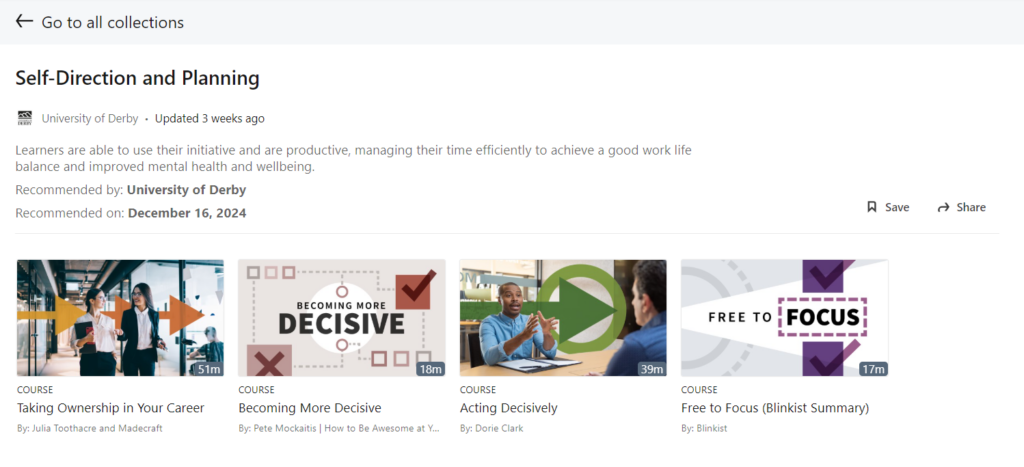By Pubudu Gunawardhana, Learning Technologist (Curriculum Development)
In today’s fast-paced world, staying organised is key to effective learning. One tool that academic staff and students can use to fulfil this purpose is the use of LinkedIn Learning Collections. LinkedIn Learning (UoD Staff Only) offers a plethora of resources that can be curated into collections, providing a structured and personalised learning experience for students.
Understanding LinkedIn Learning Collections
LinkedIn Learning offers thousands of courses across various domains, including business, technology, and creative skills. Educators can create “collections”- which are curated sets of courses, videos, and documents tailored to specific learning objectives. It is possible to create as many collections as you’d like, around topics or themes that fit the learning needs. This allows academics to provide a customised learning experience to meet the unique needs of students, making it easier to manage and track their learning progress. For instance, if you’re passionate about Team sports, you can create a Team sports collection. This collection can include a range of courses across specific topics and skills that you want to learn. Each collection can be expanded, edited, and updated to meet or change the learning goals. This means that it is possible to continuously add new courses, remove outdated ones, and reorganise the content to better suit any evolving interests and needs.
Using LinkedIn Learning Collections offers a multitude of benefits that can significantly enhance the educational experience for both students and educators in higher education. For example:
- Flexibility: One of the great advantages of using collections is the flexibility they offer. Learners do not need to complete all courses or elements within a collection but can use the collections to identify the courses and materials that best suit their interests and needs. Learners can pick and choose the content that is most relevant to them, allowing them to focus on the areas where the most improvement is needed. It ensures that the learning journey is always aligned with personal and professional development. Furthermore, the platform is accessible on various devices, including smartphones and tablets, making it easy for students to access learning materials anytime, anywhere.
- Earn certificates and badges: Upon completion of most of the courses, learners can earn certificates and badges that they can display on their LinkedIn profiles. These credentials can enhance the resume and demonstrate their commitment to continuous learning and professional development.
- Professional development: There is a possibility of using LinkedIn Learning Collections to help students develop practical skills that are highly valued in the job market. By integrating these collections into the curriculum, academics can ensure that students are not only gaining theoretical knowledge but also acquiring the skills needed to succeed in their careers. LinkedIn Learning is integrated with LinkedIn, the professional networking platform. This integration allows students to connect with industry professionals, join relevant groups, and explore job opportunities, enhancing their career prospects.
Implementing best practice when using LinkedIn Learning collections can help academic colleagues to maximise their effectiveness. Following are some tips to consider:
- Review regularly: Since the educational sector is constantly evolving, it is essential to keep the collections up to date. Regular review and update of the content in the collections will ensure that it remains relevant and aligned with current industry trends and academic standards.
- Use as pre or post-session resources: Use LinkedIn Learning Collections as supplementary material to complement your teaching resources. This can provide students with additional perspectives and deepen their understanding of the subject matter.
- Encourage student engagement: Academics can encourage students to actively engage with the content in the collections. This can be done through discussion forums, group projects, and interactive assignments. Active engagement helps students retain information better and hence make the most out of the collections.
- Use analytics: LinkedIn Learning provides analytics and insights that can help educators understand how students are interacting with the content. Use these insights to identify popular courses, track completion rates, and assess the overall effectiveness of the collections. This data-driven approach can inform future content curation and improve the learning experience.
Supporting Student Success at the University of Derby with LinkedIn Learning collections.
At the University of Derby, we understand the importance of developing essential skills for success in academic study, industry, and wider society. To support this, we have curated specialised LinkedIn Learning collections which align with 10 key skills. These collections are designed to provide students with the resources they need to excel in their studies and beyond.
Currently, there are 10 collections available for staff and students. These have been carefully curated to include courses that cover a wide range of topics within each skill area. For example, the Critical Thinking collection includes courses on problem-solving, decision-making, and analytical thinking, while the Self-Direction & Planning collection focuses on time management, goal setting, and personal productivity.

Staff and students can access these collections by logging in to LinkedIn Learning and heading to the “Recommended by the University of Derby” section. This dedicated section makes it easy to find and access the collections that are most relevant to the learning needs. Once a user has found a collection of interest it is possible to start exploring the courses and materials it contains.
LinkedIn Learning Collections offer a powerful tool for academic colleagues to organise and enhance student learning. By integrating these collections into the curriculum and following best practices, you can create a dynamic and engaging learning environment that supports student success.